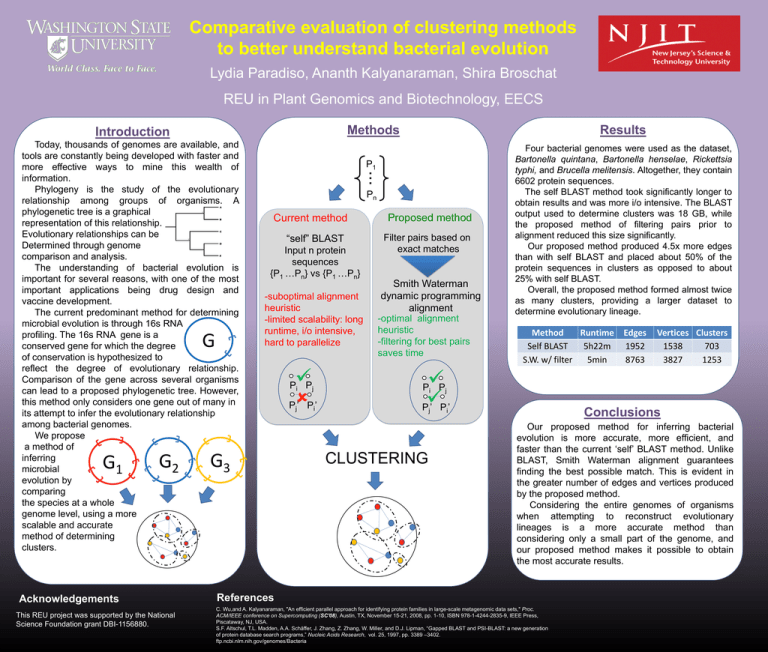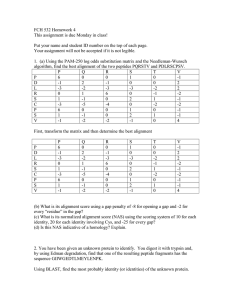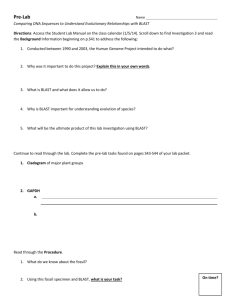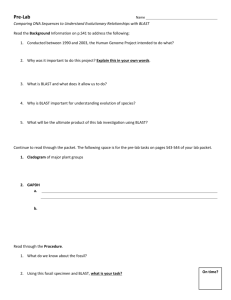Comparative evaluation of clustering methods to better understand bacterial evolution
advertisement

Comparative evaluation of clustering methods
to better understand bacterial evolution
Lydia Paradiso, Ananth Kalyanaraman, Shira Broschat
REU in Plant Genomics and Biotechnology, EECS
G
G
Acknowledgements
This REU project was supported by the National
Science Foundation grant DBI-1156880.
P1
...
Today, thousands of genomes are available, and
tools are constantly being developed with faster and
more effective ways to mine this wealth of
information.
Phylogeny is the study of the evolutionary
relationship among groups of organisms. A
phylogenetic tree is a graphical
representation of this relationship.
Evolutionary relationships can be
Determined through genome
comparison and analysis.
The understanding of bacterial evolution is
important for several reasons, with one of the most
important applications being drug design and
vaccine development.
The current predominant method for determining
microbial evolution is through 16s RNA
profiling. The 16s RNA gene is a
conserved gene for which the degree
of conservation is hypothesized to
reflect the degree of evolutionary relationship.
Comparison of the gene across several organisms
can lead to a proposed phylogenetic tree. However,
this method only considers one gene out of many in
its attempt to infer the evolutionary relationship
among bacterial genomes.
We propose
a method of
inferring
microbial
3
2
1
evolution by
comparing
the species at a whole
genome level, using a more
scalable and accurate
method of determining
clusters.
G
Results
Methods
Introduction
Pn
Current method
“self” BLAST
Input n protein
sequences
{P1 …Pn} vs {P1 …Pn}
-suboptimal alignment
heuristic
-limited scalability: long
runtime, i/o intensive,
hard to parallelize
G
P P
P’ P’
i
j
j
i
Proposed method
Filter pairs based on
exact matches
Smith Waterman
dynamic programming
alignment
-optimal alignment
heuristic
-filtering for best pairs
saves time
Four bacterial genomes were used as the dataset,
Bartonella quintana, Bartonella henselae, Rickettsia
typhi, and Brucella melitensis. Altogether, they contain
6602 protein sequences.
The self BLAST method took significantly longer to
obtain results and was more i/o intensive. The BLAST
output used to determine clusters was 18 GB, while
the proposed method of filtering pairs prior to
alignment reduced this size significantly.
Our proposed method produced 4.5x more edges
than with self BLAST and placed about 50% of the
protein sequences in clusters as opposed to about
25% with self BLAST.
Overall, the proposed method formed almost twice
as many clusters, providing a larger dataset to
determine evolutionary lineage.
Method
Runtime Edges
Self BLAST
5h22m
1952
S.W. w/ filter
5min
8763
P P
P’ P’
CLUSTERING
i
j
j
i
Vertices Clusters
1538
703
3827
1253
Conclusions
Our proposed method for inferring bacterial
evolution is more accurate, more efficient, and
faster than the current ‘self’ BLAST method. Unlike
BLAST, Smith Waterman alignment guarantees
finding the best possible match. This is evident in
the greater number of edges and vertices produced
by the proposed method.
Considering the entire genomes of organisms
when attempting to reconstruct evolutionary
lineages is a more accurate method than
considering only a small part of the genome, and
our proposed method makes it possible to obtain
the most accurate results.
References
C. Wu,and A. Kalyanaraman, "An efficient parallel approach for identifying protein families in large-scale metagenomic data sets," Proc.
ACM/IEEE conference on Supercomputing (SC'08), Austin, TX, November 15-21, 2008, pp. 1-10, ISBN 978-1-4244-2835-9, IEEE Press,
Piscataway, NJ, USA.
S.F. Altschul, T.L. Madden, A.A. Schäffer, J. Zhang, Z. Zhang, W. Miller, and D.J. Lipman, “Gapped BLAST and PSI-BLAST: a new generation
of protein database search programs,” Nucleic Acids Research, vol. 25, 1997, pp. 3389 –3402.
ftp.ncbi.nlm.nih.gov/genomes/Bacteria







